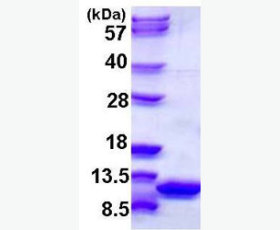Recombinant Human IL-1 Receptor Type 2/IL-1R-2
| Product name: | Recombinant Human IL-1 Receptor Type 2/IL-1R-2 |
| Source: | Human Cells |
| Purity: | Greater than 95% as determined by reducing SDS-PAGE. |
| Buffer Formulation: | Lyophilized from a 0.2 μm filtered solution of PBS, pH7.4. |
| Applications: | Applications:SDS-PAGE; WB; ELISA; IP. |
| Storage: | Avoid repeated freeze/thaw cycles. Store at 2-8 oC for one month. Aliquot and store at -80 oC for 12 months. |
| UOM: | 100ug/50ug/200ug/1mg/1g |
| Source | Human cells |
| Description | Recombinant Human Interleukin-1 receptor type 2/IL-1R-2 is produced by our Mammalian expression system and the target gene encoding Phe14-Glu343 is expressed fused with a Fc tag at the C-terminus. |
| Names | Interleukin-1 receptor type 2, IL-1R-2, IL-1RT-2, IL-1RT2, CD121 antigen-like family member B, CDw121b, IL-1 type II receptor, Interleukin-1 receptor beta, IL-1R-beta, Interleukin-1 receptor type II, CD121b |
| Accession # | P27930 |
| Formulation | Lyophilized from a 0.2 μm filtered solution of PBS, pH7.4. |
| Shipping |
The product is shipped at ambient temperature. |
| Reconstitution |
Always centrifuge tubes before opening. Do not mix by vortex or pipetting. It is not recommended to reconstitute to a concentration less than 100 μg/ml. Dissolve the lyophilized protein in ddH2O. Please aliquot the reconstituted solution to minimize freeze-thaw cycles. |
| Storage |
Lyophilized protein should be stored at < -20°C, though stable at room temperature for 3 weeks. Reconstituted protein solution can be stored at 4-7°C for 2-7 days. Aliquots of reconstituted samples are stable at < -20°C for 3 months. |
| Purity |
Greater than 95% as determined by reducing SDS-PAGE. |
| Endotoxin | Less than 0.1 ng/µg (1 IEU/µg) as determined by LAL test. |
| Amino Acid Sequence |
FTLQPAAHTGAARSCRFRGRHYKREFRLEGEPVALRCPQVPYWLWASVSPRINLTWHKNDSARTV PGEEETRMWAQDGALWLLPALQEDSGTYVCTTRNASYCDKMSIELRVFENTDAFLPFISYPQILT LSTSGVLVCPDLSEFTRDKTDVKIQWYKDSLLLDKDNEKFLSVRGTTHLLVHDVALEDAGYYRCV LTFAHEGQQYNITRSIELRIKKKKEETIPVIISPLKTISASLGSRLTIPCKVFLGTGTPLTTMLW WTANDTHIESAYPGGRVTEGPRQEYSENNENYIEVPLIFDPVTREDLHMDFKCVVHNTLSFQTLR TTVKEIEGRDMDPKSCDKTHTCPPCPAPELLGGPSVFLFPPKPKDTLMISRTPEVTCVVVDVSHE DPEVKFNWYVDGVEVHNAKTKPREEQYNSTYRVVSVLTVLHQDWLNGKEYKCKVSNKALPAPIEK TISKAKGQPREPQVYTLPPSRDELTKNQVSLTCLVKGFYPSDIAVEWESNGQPENNYKTTPPVLD SDGSFFLYSKLTVDKSRWQQGNVFSCSVMHEALHNHYTQKSLSLSPGK
|
| Background | Interleukin-1 receptor type 2 (IL1R2) belongs to the interleukin-1 receptor family. Two distinct types of IL1 receptors which are able to bind IL1 specifically have been identified, designated as IL1RI (IL1RA) and IL1RII (IL1RB). IL1 receptor type II is a 68 kDa transmembrane protein found on B lymphocytes, neutrophils, monocytes, large granular leukocytes and endothelial cells. IL1R2 is non-signaling receptor forIL1A, IL1B and IL1RN, reduces IL1B activities. IL1R2 serves as a decoy receptor by competetive binding to IL1B and preventing its binding to IL1R1. IL1R2 modulates cellular response through non-signaling association with IL1RAP after binding to IL1B. IL1R2 (membrane and secreted forms) preferentially binds IL1B and poorly IL1A and IL1RN. The secreted IL1R2 recruits secreted IL1RAP with high affinity; this complex formation may be the dominant mechanism for neutralization of IL1B by secreted/soluble receptors. |














